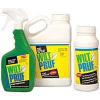Adding A Pond to Your Yard or Garden
Installing a Pond and Pond Liner
Follow the formula below to determine the size of pond liner you will need.
Length = Length of Pond + Depth (x2) + 3
Width = Width of Pond + Depth (x2) + 3
Example, for a pond that is 12ft long, 10ft wide and 3ft deep:
12 + 6 + 3 = 21ft
10 + 6 + 3 = 19ft
You would need a liner that is 21ft by 19ft.
The first step for installing your pond is to lay out the shape and dig it out. The best way to lay out your pond shape is with a garden hose, which is heavy enough to not blow away, yet flexible enough to create nice smooth curves. You can also use chalk or spray paint to mark the edge.
Begin digging out your pond from the center, using a wheel barrow to haul away the dirt to your waterfall area or another area you have planned to use the dirt. A good pond depth is 2-4ft. Be sure to check building codes in your area – some require a fence around bodies of water that are a certain depth. When measuring your depth, account for an extra two inches of sand that will be added. This sand will help protect the Liner from any sticks or rocks that could puncture it. Leave a plant shelf at least 12” wide and 18” deep around the edge of the pond. Do not attempt to have 90 degree angles along the edges, instead dig the sides at a 60-70 degree angle. Remove the sod around the edge of the pond – about 12-15” wide and 2-3” deep. This area will be where you can add stone, coping, boulders and landscaping to decorate the border of your pond.
Remember to periodically check that everything is level while digging!
Once you have dug out the shape of your pond, go in and remove as many sticks, stones and other sharp objects as possible. Then add in the two inches of sand to protect your liner and provide a cushion under the pond. Lay your liner over the hole you have dug, with the excess liner distributed equally on all sides. Secure the edges of the liner with rocks/bricks and begin filling with water, making adjustments as you go to remove as many folds and pleats as possible (some fold and/or pleats are inevitable). As the liner becomes taut, readjust the bricks to allow the liner to sink down and fill with water. Remember, it is not necessary to try to manually contour the liner to the pond, as the water will do that for you as it fills.
Once the pond is full, you may trim the excess liner, bury it or hide it with coping stone. Please contact our Water Gardening department if you have further questions, at 247-6236.
Tips for Water Clarity
Wondering how to get rid of the green water in your pond? Try a natural way to reduce the algae, with plants and water aeration. Filters with UV light are the best solution for homeowners to keep the pond in balance and free of algae, and a UV clarifier controls algae right from the start. The addition of bacteria can also help balance the pond.
How to Choose the Correct Pond Pump
Knowing the number of gallons in your pond is necessary to determine the size of a pump and filter you need, as well as the number of fish and plants your pond can sustain. Use the following formulas to determine the number of gallons in your pond:
Rectangular Pond:
Gallons = Length x Width x Depth x 7.5
Circular Pond:
Gallons = Radius x Radius x 3.14 x Depth x 7.5
A pump’s filtration efficiency is measured in Gallons Per Hour (GPH), which is rated at one foot. A pump will turn water once every two hours. For example, a pump rated at 500 GPH will filter 1,000 gallons of water efficiently.
Because they lose efficiency the higher they have to pump water, pumps have a maximum head height (maximum height they will pump to). When measuring the pumping height, use the surface of the water to start your measurement.







